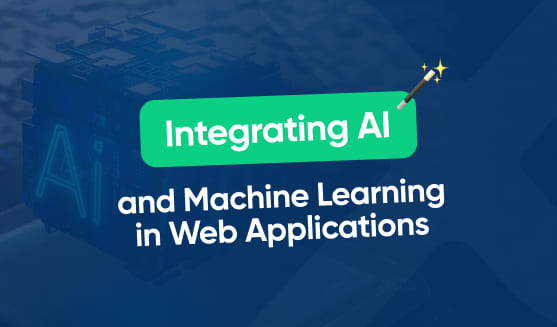
Artificial Intelligence (AI) and Machine Learning (ML) have become increasingly prevalent in numerous industries, revolutionizing the way we interact with technology. In the realm of web applications, AI and ML are instrumental in enhancing user experiences and delivering personalized solutions. Understanding the basics of AI and ML, as well as their intersection with web applications, is essential for harnessing their full potential.
Understanding AI and Machine Learning
Defining AI and Machine Learning
AI refers to the creation of intelligent machines that can simulate human intelligence in tasks such as decision making, problem-solving, and natural language processing. It encompasses a breadth of techniques and methodologies aimed at developing systems capable of mimicking human cognitive abilities. On the other hand, ML is a subset of AI that focuses on algorithms and statistical models that enable computational systems to learn from data and improve their performance over time.
Artificial Intelligence (AI) has evolved significantly over the years, with researchers and developers exploring various approaches to replicate human-like intelligence in machines. From symbolic AI, which relies on predefined rules and logic, to the more recent advancements in neural networks and deep learning, the field of AI continues to push the boundaries of what machines can achieve. Machine Learning (ML), a key component of AI, leverages algorithms to enable computers to learn from and make predictions or decisions based on data. This iterative learning process is fundamental to the development of AI systems that can adapt and improve their performance autonomously.
The Importance of AI and Machine Learning in Web Applications
Web applications have become integral parts of our lives, enabling us to communicate, shop, and access information with ease. Integrating AI and ML in web applications offers numerous benefits, such as improving user engagement, personalizing recommendations, automating processes, and enhancing overall user satisfaction. These technologies have the potential to transform static websites into dynamic, intelligent platforms that cater to individual needs and preferences.
AI and ML technologies are revolutionizing the way web applications interact with users, providing personalized experiences that were once thought to be the realm of science fiction. By analyzing user behavior and preferences, AI-powered web applications can offer tailored recommendations, content, and services in real-time, creating a more immersive and engaging user experience. Additionally, the integration of AI algorithms can streamline backend processes, such as data processing and analysis, leading to faster response times and more efficient operations for web applications.
The Basics of Web Applications
What is a Web Application?
A web application is a software program accessible through a web browser that allows users to interact with information or perform specific tasks. Unlike traditional desktop applications, web applications are hosted on web servers and accessed via URLs, eliminating the need for installation and enabling cross-platform compatibility. They can range from simple single-page applications to complex enterprise systems.
Web applications have become an integral part of our daily lives, powering various online services such as social media platforms, e-commerce websites, and productivity tools. They leverage the capabilities of web technologies to provide dynamic and interactive user experiences.
Key Components of a Web Application
A web application comprises various components that work together to deliver its functionality. These include the front-end (client-side) components responsible for the user interface and interaction, the back-end (server-side) components handling data processing and storage, and the database management system for storing and retrieving data. Web applications also rely on protocols such as HTTP for communication between clients and servers.
The front-end of a web application is typically built using technologies like HTML, CSS, and JavaScript, which determine the layout, styling, and interactivity of the user interface. On the other hand, the back-end consists of server-side languages such as PHP, Python, or Node.js, which manage the application logic and interact with the database to retrieve or store data.
The Intersection of AI, Machine Learning, and Web Applications
How AI and Machine Learning Enhance Web Applications
The integration of AI and ML in web applications opens up new possibilities for improving user experiences and providing intelligent solutions. AI-powered recommendation systems can analyze user behaviors and preferences to offer personalized content, product recommendations, and tailored suggestions. Machine Learning algorithms can also be employed for tasks such as sentiment analysis, natural language processing, and computer vision, enhancing search functionalities and enabling more intuitive user interactions.
Moreover, the utilization of AI and ML in web applications can lead to significant advancements in automation. Tasks that traditionally required manual intervention can now be automated through intelligent algorithms, increasing efficiency and reducing human error. For instance, chatbots powered by AI can provide instant customer support, responding to inquiries and resolving issues in real-time, thereby enhancing user satisfaction and streamlining business operations.
Challenges in Integrating AI and Machine Learning into Web Applications
Despite their potential benefits, integrating AI and ML into web applications poses certain challenges. Data quality and availability are crucial for effective ML models, meaning that acquiring and preprocessing diverse and relevant data can be time-consuming. The complexity of ML algorithms and their training processes may also increase the computational requirements of web applications, necessitating robust infrastructure and efficient resource management. Furthermore, ensuring the privacy and security of user data becomes paramount when implementing AI and ML solutions.
In addition to technical challenges, ethical considerations also come into play when integrating AI and ML into web applications. Issues such as algorithmic bias, transparency, and accountability need to be carefully addressed to ensure fair and responsible use of these technologies. Moreover, the potential impact of AI and ML on job displacement and societal dynamics requires thoughtful planning and proactive measures to mitigate any negative consequences and promote inclusive growth.
Steps to Integrate AI and Machine Learning in Web Applications
Planning the Integration Process
Before embarking on the integration journey, thorough planning and requirements analysis are essential. Identifying the specific use cases and objectives of AI and ML integration helps determine the necessary resources, technologies, and expertise required for success. Additionally, setting realistic goals and aligning them with user expectations is crucial for achieving meaningful results.
During the planning phase, it is important to consider the ethical implications of AI and ML integration. Ensuring that the technology is used responsibly and in compliance with privacy regulations is of utmost importance. This involves establishing clear guidelines and policies to protect user data and maintain transparency in the decision-making processes of AI algorithms.
Choosing the Right AI and Machine Learning Tools
Choosing suitable AI and ML tools depends on factors such as the nature of the problem, the available data, and the desired outcome. Open-source libraries, frameworks, and cloud-based AI services offer a range of options for developers to leverage pre-built models or create custom solutions. Evaluating the performance, scalability, and compatibility of these tools is crucial to ensure seamless integration with existing web applications.
Furthermore, it is essential to consider the long-term sustainability of the chosen AI and ML tools. Keeping up with advancements in the field and selecting tools that have a strong community support and regular updates will help future-proof the integration. This ensures that the web application can adapt to evolving user needs and take advantage of emerging technologies.
Implementing AI and Machine Learning Features
Implementing AI and ML features requires a systematic approach, involving tasks such as data collection and preprocessing, model selection and training, and integration with the web application’s architecture. With an appropriate data pipeline, developers can leverage ML algorithms to analyze user patterns, make predictions, or automate complex processes. Monitoring and fine-tuning the performance of these features is essential to deliver accurate and reliable results.
When implementing AI and ML features, it is important to consider the interpretability and explainability of the models. Understanding how the algorithms arrive at their decisions can help build trust with users and ensure that the technology is not perceived as a “black box.” By providing explanations and visualizations of the underlying processes, developers can enhance transparency and enable users to make informed decisions based on the AI-generated insights.
Evaluating the Success of AI and Machine Learning Integration
Measuring User Engagement and Satisfaction
The success of AI and ML integration in web applications can be evaluated through various metrics. User engagement, measured by factors like click-through rates, session duration, or interactions with AI features, provides insights into how well the system captures and retains user attention. Additionally, obtaining user feedback through surveys or user testing sessions enables the assessment of user satisfaction and usability, highlighting areas for improvement.
Analyzing the Performance of AI and Machine Learning Features
Quantitative analysis of AI and ML features’ performance is crucial to ensure their effectiveness and reliability. Metrics such as accuracy, precision, recall, and response time provide objective measures of how well the system performs its intended tasks. Continuous monitoring, error analysis, and A/B testing help identify and address potential issues, enabling iterative enhancements and refinements.
In conclusion, integrating AI and ML in web applications offers immense potential to revolutionize user experiences through personalized recommendations, automated processes, and intelligent interactions. Understanding the fundamentals of AI and ML, as well as the challenges and best practices in their integration, is crucial for effectively harnessing their power. By following a systematic approach and evaluating the success of integration, developers can create web applications that deliver enhanced value and engage users on a deeper level.


